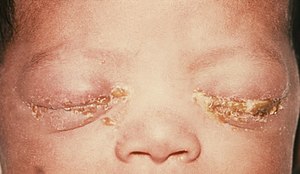Neonatal conjunctivitis
| Neonatal conjunctivitis | |
|---|---|
 |
|
| A newborn with gonococcal ophthalmia neonatorum | |
| Classification and external resources | |
| Specialty | pediatrics |
| ICD-10 | A54.3, P39.1 |
| ICD-9-CM | 098.40, 771.6 |
| DiseasesDB | 9237 |
| MedlinePlus | 001606 |
| eMedicine | oph/325 |
| MeSH | D009878 |
Neonatal conjunctivitis, also known as ophthalmia neonatorum, is a form of conjunctivitis and a type of neonatal infection contracted by newborns during delivery. The baby's eyes are contaminated during passage through the birth canal from a mother infected with either Neisseria gonorrhoeae or Chlamydia trachomatis. Antibiotic ointment is typically applied to the newborn's eyes within 1 hour of birth as prevention against gonococcal ophthalmia. Most hospitals in the United States are required by state law to apply eye drops or ointment soon after birth to prevent the disease. If left untreated it can cause blindness.
Neonatal conjunctivitis by definition presents during the first month of life. It may be infectious or non infectious. In infectious conjunctivitis, the organism is transmitted from the genital tract of an infected mother during birth or by infected hands.
The disease incidence varies widely depending on the geographical location. The most extensive epidemiological survey on this subject has been carried out by Dharmasena et al. who analysed the number of neonates who developed neonatal conjunctivitis in England from 2000 to 2011. In addition to the incidence of this sight threatening infection they also investigated the time trends of the disease. According to them the incidence of Neonatal conjunctivitis (Ophthalmia Neonatorum) in England was 257 (95% confidence interval: 245 to 269) per 100,000 in 2011.
Chemical causes: Right after delivery
Neisseria gonorrhoeae: Delivery of the baby until 5 days post-birth (Early onset).
Chlamydia trachomatis: 5 days post-birth to 2 weeks (Late onset—C.trachomatis has longer incubation period)
Untreated cases may develop corneal ulceration, which may perforate resulting in corneal opacification and Staphyloma formation.
Chemical irritants such as silver nitrate can cause chemical conjunctivitis, usually lasting 2–4 days. Thus, prophylaxis with a 1% silver nitrate solution is no longer in common use. In most countries neomycin and chloramphenicol eye drops are used instead. However, it is possible for newborns to suffer from neonatal conjunctivitis due to reactions with chemicals in these common eye drops. Additionally, a blocked tear duct may be another non-infectious cause of neonatal conjunctivitis.
...
Wikipedia
